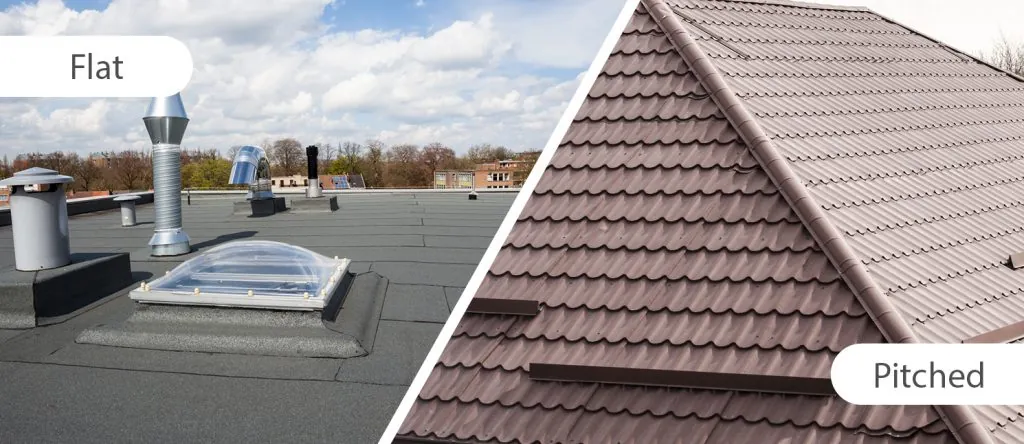Choosing between a flat roof and a pitched roof is a key decision when constructing or renovating a property. Both styles offer distinct advantages and are suited for different architectural designs, climates, and usage needs. In this guide, we’ll break down all aspects of flat roof vs pitched roof to help you make the most informed choice.
Flat Roof vs Pitched Roof
A flat roof isn’t completely flat—it typically has a slight pitch (about 1–10 degrees) to allow for water drainage. It creates a minimalist, modern appearance and is often seen in commercial buildings or contemporary homes.
On the other hand, a pitched roof features a steeper slope that allows rain and snow to run off easily. Pitched roofs are traditional in residential architecture and come in various styles, including gable, hip, and mansard roofs. They offer a classic and timeless aesthetic.
Cost Comparison
Flat roofs generally cost less to install due to simpler designs, fewer materials, and quicker construction. They are ideal for budget-conscious projects, especially in urban settings.
Pitched roofs usually involve more materials (like rafters, underlayment, and shingles), more labor, and longer construction time, making them more expensive upfront. However, they may require fewer repairs in harsh weather conditions, which can reduce long-term costs.
Typical cost comparison:
-
Flat Roof: $5 – $10 per sq. ft.
-
Pitched Roof: $7 – $15 per sq. ft.
Durability and Lifespan
Pitched roofs tend to outlast flat roofs due to their superior ability to shed water, snow, and debris. With proper maintenance, a pitched roof can last 30–50 years, depending on the material.
Flat roofs usually last around 15–25 years, though newer materials like TPO and PVC have improved durability. Their low pitch makes them more vulnerable to water pooling, which can lead to leaks and damage if not managed well.
Maintenance Requirements
Flat roofs require regular maintenance to prevent drainage issues, pooling, and membrane damage. Roof inspections, clearing drains, and checking for punctures are essential.
Pitched roofs, though easier in terms of water management, can still collect leaves, especially in valleys or around chimneys. Snow accumulation may need attention in colder regions, but overall maintenance is generally less frequent.

Climate Suitability
The local climate plays a big role in which roof type is better:
-
Cold and snowy regions: Pitched roofs are ideal as they allow snow to slide off naturally, reducing structural load.
-
Hot and dry climates: Flat roofs can work well, especially when built with reflective or insulated materials to reduce heat gain.
-
Rainy environments: Pitched roofs outperform flat roofs thanks to faster water runoff, reducing the risk of leaks.
Energy Efficiency
Flat roofs make insulation more consistent and easier to install beneath the membrane. They’re also more accessible for solar panels, HVAC units, or reflective coatings that lower energy use.
Pitched roofs often allow for attic ventilation and natural airflow, which helps regulate temperature and prevent moisture buildup. Energy efficiency varies depending on the roof material and construction.
Usability and Space
Flat roofs offer usable outdoor space—perfect for rooftop gardens, patios, or mounting mechanical equipment in commercial buildings.
Pitched roofs, by contrast, offer interior space such as an attic or even extra living space if converted into a loft. This is a major benefit in homes that need storage or future expansion potential.
Installation and Construction Time
Flat roofs are faster and easier to construct, which can shorten project timelines. They involve fewer angles and components, making them simpler for contractors.
Pitched roofs require more labor and time. Framing, cutting, and installing multiple layers (decking, underlayment, shingles) adds complexity. This can delay construction, especially on custom roof shapes.
Resale Value and Curb Appeal
Pitched roofs often increase curb appeal and resale value, particularly in suburban or traditional neighborhoods. Their familiar style is preferred by many homebuyers and can make a property more attractive.
Flat roofs can also boost value, especially in urban areas or modern architecture where minimalist design is prized. However, in some markets, they may be viewed as less desirable due to perceived maintenance concerns.
Flat Roof vs Pitched Roof: Pros and Cons Table
| Feature | Flat Roof | Pitched Roof |
|---|---|---|
| Cost | Lower upfront cost | Higher upfront cost |
| Lifespan | 15–25 years | 30–50 years |
| Maintenance | Regular drainage checks | Less frequent, easier water runoff |
| Climate Suitability | Best for dry or mild climates | Ideal for wet, snowy, or cold climates |
| Energy Efficiency | Good with coatings and solar setups | Good ventilation, depends on attic design |
| Space Usage | Rooftop usable for garden or HVAC | Attic or loft space available |
| Curb Appeal | Modern, minimalist look | Traditional and widely accepted look |
Still Unsure About Flat vs Pitched Roof?
Choosing the right roof can be challenging—but JMCC Roofing Services is here to help. Whether you’re building new or replacing an old roof, our team offers expert advice and the best roofing services tailored to your needs. Contact JMCC Roofing Services today for a free consultation and find the perfect fit for your home or commercial property.
Conclusion
When it comes to choosing between a flat roof vs pitched roof, there’s no one-size-fits-all answer. Flat roofs are modern, cost-effective, and perfect for space-maximizing designs—especially in urban or commercial settings. Pitched roofs are reliable, long-lasting, and ideal for homes in colder or wetter climates.
Your decision should consider:
-
Budget
-
Architectural style
-
Climate
-
Energy goals
-
Space needs
Consulting with a roofing professional can help you evaluate local conditions and building codes to make the best decision for your project.




